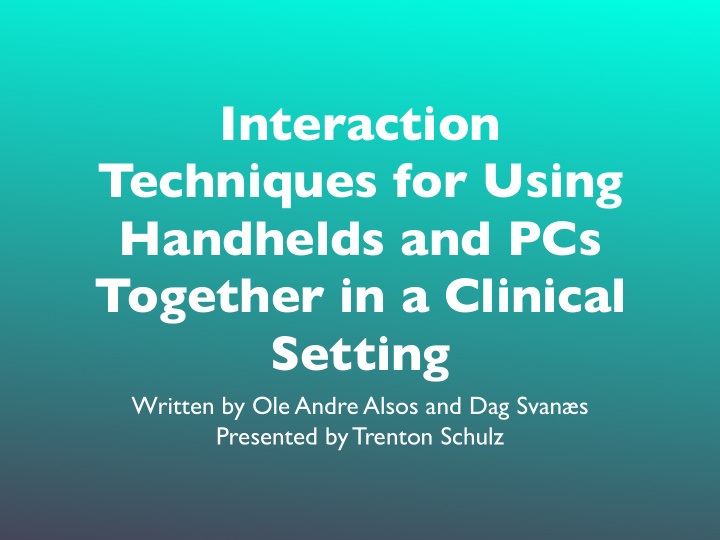



Interaction Techniques for Using Handhelds and PCs Together in a Clinical Setting Written by Ole Andre Alsos and Dag Svanæs Presented by Trenton Schulz
Introduction—I • People use a wide variety of handheld devices in many different environments • Hardware: close to dream of Ubiquitous Computing • Software: long way to go…
Introduction—II • Hospital/Clinical settings could benefit from using multiple devices • Information and communication intensive AND mobile • Existing studies show benefit for mobile computing and contextual information
Background—I • Regional hospital in Trondheim updated • Patient terminals for entertainment, control • PDA for medical staff Can they work together?
Background—II • Assumptions: • Integrated RFID/barcode readers • Network infrastructure so any PDA can communicate with any patient terminal or any other PDA
The Study • Research Questions: 1. To get comparable usability and user preference data for the interaction techniques 2. To learn what social and contextual factors affect their usability
Research Design User Understanding 1. Workshop with health works to find scenarios 2. Verify scenarios with experienced physician 3. Develop prototypes for scenario Prototyping 4. Test prototypes Evaluating 5. Rank prototypes
Scenario—I • “…a physician wants to show a patient a set of X-rays prior to surgery. The physician has the X-ray images available on a PDA, and can use the patient terminal as an additional display unit.”
Scenario—II • Patient has arthritis in the left elbow joint • Doctor to explain condition and inform about need for surgery • Has seven X-ray images • Two from affected elbow, two from the other • Extra images for other patients
Technique A • WIMP on PC • Base interface
Technique B • Drag and drop • Icons from the top represent X-rays • Icon at bottom represents terminal
Technique C • Screen extension • Similar to using two screens on Windows, Mac, Xinerama
Technique D • The PDA as input device • The user controls the mouse pointer with the stylus on the PDA
Technique E • Remote Control • PDA functions like a TV or DVD remote
Technique F • WIMP on PDA • All WIMP interaction is done on the PDA • Terminal shows the results
Technique G • Proximity • The user selects information on the PDA and moves it toward the terminal screen • When it is close enough the image is shown
Technique H • Mirroring • PDA has a scaled down version of what is shown on the terminal
Results—A • No problems presenting • Physician explained as used the device • One patient wanted to press the screen too
Results—B • Three of the physicians expected the image to appear immediately • Two didn’t know where they should drag the image • Two tried to drag image back
Results—C • Three saw this as another drag and drop, two realized it was a desktop extension • Problem with implementation
Results—D • Most felt that this was awkward and pointless, the patient terminal is too close • Two suggested interface similar to technique F
Results—E • Interaction lead to lots of focus shifts between the PDA and the terminal • Some commented that it was easy to use the terminal dirrectly
Results—F • Everyone found this easy and fast to use • Some complained about focus shifts, since there were three things
Results—G • Most felt that it was awkward and unnecessary to move the PDA towards the terminal
Results—H • Most felt that the small screen made the menu difficult to see • “…no value in seeing on the same on the PDA and screen.”
Results—Summary • Technique A and F were the two most preferred • All the others had some usability problems • Preference rankings indicate F then A
Usability Factors • User interface usability • Ergonomics and screen size • Shared view vs. hiding information on PDA • Focus shifts and time away from the patient
Discussion • Combined results (evaluation and preference) indicate F is the best techinque • Low number of people (five pairs) means that predictive power potentially weak • Not dealt with login issues or identification
Conclusion • “…designers of integrating handhelds and stationary displays should pay attention to factors beyond the user interface such as physical properties of the settings and the social aspects of the physician-patient interaction.”
Recommend
More recommend